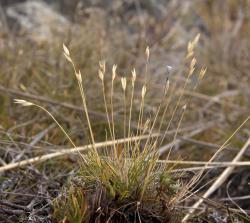- Taxon
- Gallery
Small tufted bright green tussock and persistent old stramineous leaves below shoots of 3–4 conspicuously divergent leaf blades on widely spaced intravaginal innovations, ≪ erect culms. Prophyll 7–10 mm, keels long hairy, interkeels hairy, setae <1 mm hairy. Leaf-sheath 1–1.5 cm, glabrous, ridged, becoming stramineous; collar thickened, paler than sheath; apical tuft 0.5–1–1.5 mm, sparse. Ligule a very narrow row of hairs c. 0.25 mm. Leafblade 2.5–3 cm × 0.5 mm, ± terete; persistent, tardily disarticulating at ligule; glabrous abaxially except keel hairy apically; adaxially with many small white prickles on nerves; margin glabrous. Culm to 12 cm, internodes rigid, erect, tough, glabrous, inflorescence internode 4–6 cm. Inflorescence a raceme, 1.0– 1.7 cm, of 2–3–5 widely spaced solitary overlapping spikelets on very finely toothed pedicels 2–3–5 mm, rachis very finely toothed. Spikelets 6–8 mm, of 3–5 florets; awns exserted. Glumes equal, ± ovate–acute 5–6 mm, glabrous, bright green centrally, margins hyaline sometimes empurpled below, faintly toothed above, apex finely ciliate, nerves confluent; upper 5-nerved, lower 3-nerved, adaxially with abundant very small white hairs. Lemma 2 mm, bright green, 7-nerved, nerves anastomosing below sinus; upper row of hairs only in marginal tufts, 0.75 mm, ≥ sinus, or with one or two central tufts of 1–few hairs > sinus, < awn column; lower row only of marginal tufts, 0.5 mm, not reaching upper marginal tufts, elsewhere glabrous; lemma lobes 1.5–2.5 mm ≥ lemma, abruptly produced into awns 1–1.5 mm, margins empurpled; central awn 1.5–2.5, reflexed from twisting column 1 mm. Palea 2.5 mm, > sinus, broad, keels densely long ciliate above, glabrous and narrow below; apex entire, ciliate; adaxially hairy above. Callus 0.25 mm, rounded, marginal hair tufts 0.4–0.6 mm, not reaching tufts of lower row of lemma. Rachilla 0.3–0.5 mm, glabrous. Lodicules 0.4–0.5 mm, hairs 1–2 = lodicule; nerved, cuneate and lobed. Anthers 0.7–1.0 mm, yellow, apiculate, exserted. Gynoecium: ovary 0.5–0.8 mm, obovoid, stipitate, stigma-styles 1.2–1.5–1.75 mm, exserted, remnant of third style present. Caryopsis 1.4–1.5 mm × 0.75 mm, obovate, free; embryo 0.5–0.6 mm; hilum 0.3–0.4 mm.
[Reproduced from Molloy & Connor (2005, New Zealand J. Bot. 43: 721–743) with permission from The Royal Society of New Zealand.]




